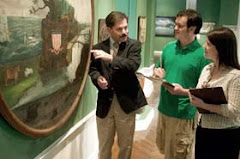Here's another great piece from the Katcher Collection of Americana that we will feature in the Fenimore Art Museum's upcoming exhibition, Inspired Traditions (see information about our related symposium on October 1 here). It's an exuberant sign proudly displaying its owner’s name and, perhaps, his highly abstracted likeness. From the looks of it, you would think that the business was thriving. The historical record tells a quite different story.
Morris Lord (1794-1849) inherited a portion of his father’s estate and for the time enjoyed financial success in real estate in and around Parsonfield, Maine. By the 1820s he briefly owned a store, presumably the business advertised here. Lord suffered financial losses by 1840, possibly as a result of the Panic of 1837, and moved with his family to Lowell, Massachusetts, where he ran a boarding house. Lowell was a thriving mill town where thousands of young women migrated to take jobs in the factories, and thus boarding houses were common. It was a place where many tradesmen and merchants found some measure of financial success.
Morris Lord (1794-1849) inherited a portion of his father’s estate and for the time enjoyed financial success in real estate in and around Parsonfield, Maine. By the 1820s he briefly owned a store, presumably the business advertised here. Lord suffered financial losses by 1840, possibly as a result of the Panic of 1837, and moved with his family to Lowell, Massachusetts, where he ran a boarding house. Lowell was a thriving mill town where thousands of young women migrated to take jobs in the factories, and thus boarding houses were common. It was a place where many tradesmen and merchants found some measure of financial success.
Our Mr. Lord, alas, was not one of those who thrived in Lowell. When he died of cholera in 1849, his death certificate indicates that he was a laborer. This trade sign, therefore, documents an all-too-brief shining moment in a business career that had more than its share of setbacks. The bright side: because the store was not in business for very long, the sign here did not suffer long exposure to the elements, and thus survives in great condition for us to enjoy. I cannot imagine what Mr. Lord would think of this as his legacy.

















